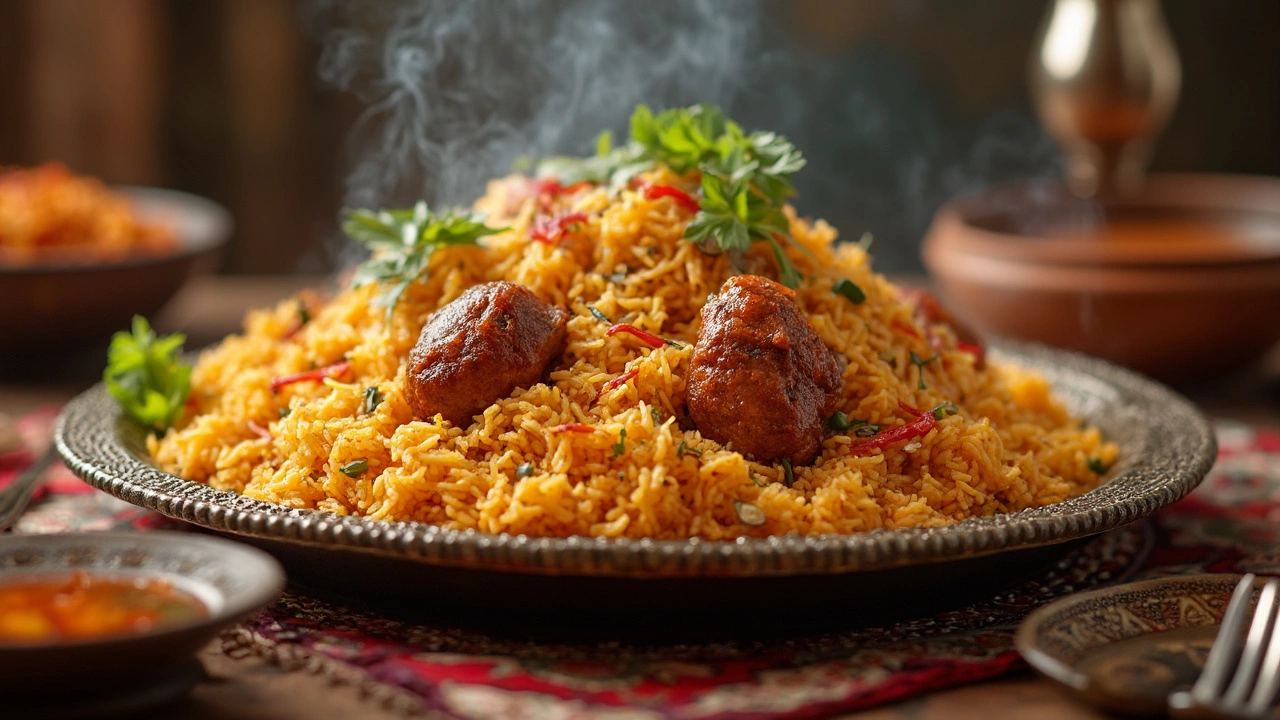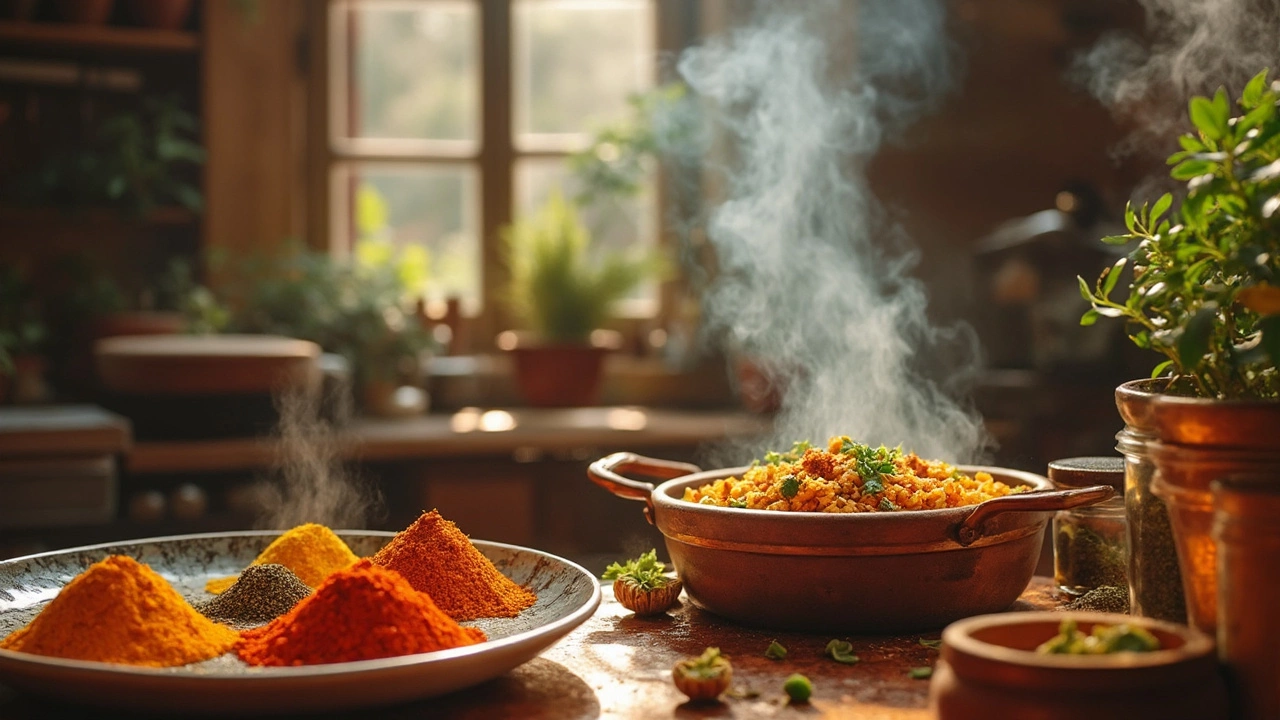11 Mar 2025
- 0 Comments
Biryani is one of those dishes that's all about layers of flavor and aroma. But how do you make sure every bite is packed with punch? It's actually simpler than you think.
First up, let's talk rice. You can't skimp here—rich, aromatic basmati is the go-to choice. Rinse it well to get rid of excess starch; this helps keep the grains separate.
Now, about spices. They're the backbone of your biryani. Think cinnamon sticks, cloves, bay leaves, and of course, saffron. Toasting spices brings out their essential oils, making the flavors more robust.
And let's not forget marination. It's essential for tender, flavorful meat. Use yogurt and spices to let the flavors really soak in. Trust me, it makes all the difference.
Choosing the Right Rice
Believe it or not, the type of rice you pick can totally make or break your biryani. It's all about those fluffy, aromatic grains that don't stick together. That's why basmati is your best buddy here.
When you're at the store, look for long grains on the package. Basmati is known for its nutty flavor and lovely aroma when cooked, which is exactly what you're aiming for in a great dish. But there's more to it than just grabbing any bag of basmati.
Top Tips for Rice Prep
- Rinse and Repeat: Give your rice a good rinse until the water runs clear. This cuts down on starch and helps keep the grains separate while cooking.
- Soak It Up: Let the rice soak for about 30 minutes before cooking. It not only speeds up cooking time but improves the texture.
- The Right Ratio: Go with one part rice to one and a half or two parts water. That's the sweet spot for perfectly fluffy grains.
A quick look at some cooking numbers can help!
| Rice Type | Water Ratio | Cooking Time |
|---|---|---|
| Basmati | 1:1.5 | 12-15 minutes |
| Jasmine | 1:1 | 10 minutes |
Don't skimp on this first step—it sets the foundation for the flavor party that's about to happen. And remember, when in doubt, go with basmati. It'll never let your biryani down.
Spice It Up
If there's one secret to making your biryani unforgettable, it's the spices. Getting this part right is crucial. Think of spices as the heartbeat of the dish—it’s what makes biryani, well, biryani!
The Essential Spice List
To properly spice it up, here's what you'll need:
- Cinnamon sticks: These add a sweet and woody aroma. A little goes a long way.
- Cloves: They bring a warm, spicy kick. Be sparing, as they can be pretty intense.
- Bay leaves: They offer a subtle depth, often acting as a base note in the symphony of flavors.
- Saffron: While more of a luxury, this adds a beautiful color and fragrance. A pinch in warm milk can work wonders.
- Cardamom pods: Both green and black cardamoms give a fresh, lemony flavor.
- Star anise: This isn't just a pretty face; it adds a sweet licorice note.
Tips for Toasting
To extract the best flavor from these spices, consider toasting them lightly. It makes a dramatic difference by unlocking the essential oils. Just a quick toss in a dry pan should do the trick. Your nose will know when it's time to stop!
Pre-Mixed Spice Blends
Feeling a bit overwhelmed by all these spices? Don't stress; there are premade biryani spice mixes available. They can be a shortcut when you're short on time but still want to pack that flavorful punch.
Whether you choose to blend your own or grab a ready mix, the goal is to strike a balance, ensuring no single spice overpowers the rest. It's all about harmony on your taste buds!

Marination Magic
If you want your biryani to shout flavor, the marinade is the voice that carries the tune. Marination isn't just a step; it's the transformation phase where flavors seep into the meat, making each bite unforgettable.
To start, you'll need the basics: yogurt, a mix of ginger-garlic paste, and a handful of spices. The acidity of the yogurt tenderizes the meat, making it soft and juicy. The longer you let it marinate, the better, but aim for at least two hours. Overnight in the fridge? Even better.
Picking the Right Spices
Your choice of spices can make or break your dish. A typical blend includes turmeric, cumin, coriander powder, and garam masala. Each has its role, adding layers of depth without overpowering the others.
The Right Balance
Too much of one element can throw off the flavor balance. A teaspoon of this and a tablespoon of that might look nice on paper, but it’s your taste buds that should guide you.
- Turmeric: Offers a vibrant color and a warm, earthy aroma.
- Cumin: Provides a smoky edge that pairs well with meats.
- Coriander powder: Adds citrusy undertones.
- Garam masala: A mix of multiple spices, adding complexity.
Adding Aromatics
Don’t forget the aromatics. Fried onions, fresh cilantro, and mint leaves can be mixed in with the marinade, releasing their own unique flavors into the meat, creating a rich tapestry of tastes.
Final Pro Tip
When combining everything, make sure your marinade covers every piece of meat fully. You want each piece to be drenched in flavor. Consider adding a splash of lemon juice for a touch of freshness.
Cooking Techniques
Mastering cooking techniques can really level up the flavor of your biryani. Here’s where the magic happens, so let’s get into it.
Layering for Flavor
Layering is key to a great biryani. Start with a layer of partially cooked rice, then add a layer of marinated meat or vegetables. Repeat this, finishing with a rice layer. This method allows each ingredient to meld, creating that signature richness.
Cooking Properly
After layering, seal the pot with foil or dough to trap the steam inside, known as 'dum' cooking. You'll allow the flavors to infuse deeply. Cook on low heat to avoid burning and ensure even cooking. Dum cooking not only preserves aromas but enhances the overall flavor profile.
Sautéing the Spices
Before you even start layering, make sure those spices are on point. Fry onions until golden brown, then sauté your spices. This step is crucial for unlocking the full potential of those spices; think of it as your biryani's secret weapon.
Judging Doneness
Wondering how long to keep it cooking? For a standard biryani, about 20-25 minutes on 'dum' is usually enough. Check if the rice grains are soft and the meat is tender. Patience is your friend here.
Additional Tips
- Use a heavy-bottomed pot to avoid burning.
- Add a splash of milk infused with saffron and rose water over the rice before sealing; it elevates the aroma.
- Check for seasoning and adjust if needed—but only add salt at the final stages.
| Step | Action |
|---|---|
| 1 | Prepare ingredients and marinate the meat. |
| 2 | Sauté onions and spices. |
| 3 | Layer rice and meat. |
| 4 | Seal the pot and cook on low heat. |
| 5 | Serve with garnishments like fried onions or fresh coriander. |

Final Touches
Alright, you've made it to the last step of creating that mouth-watering biryani. This is where the magic really happens, and it's all about finishing with flair.
Layer it Perfectly
Layering is key to ensuring every spoonful is evenly seasoned. Start by spreading a layer of cooked rice at the bottom of your pot, followed by a layer of your marinated and cooked meat or veggies. Repeat these layers until everything's in the pot.
Fried Onions and More
Top the final layer with crispy fried onions, some fresh herbs like mint and cilantro, and a drizzle of saffron-infused milk. This not only adds color but infuses each layer with rich aromas.
Dum Cooking
Now, seal the pot tight with a lid or some dough to trap the steam. Cook the biryani on low heat to allow the flavors to meld perfectly. This step, known as 'dum cooking,' is what gives biryani its distinctive taste and texture.
"Sealing in the steam is what gives biryani its unique taste," says Chef Anjum Anand, an expert in Indian cuisine. "It's the melding of flavors that really makes this dish special."
Once it's done, give it a gentle stir to mix. But be careful, you don't want to break those precious rice grains.
Plating with Style
Presentation isn't everything, but it sure helps. Serve your biryani with raita or a fresh side salad. This balances the flavors and adds a refreshing contrast.
Check That Texture
If you want to get technical, the perfect biryani should have separated grains and a balanced taste of spices where nothing is overpowering.
